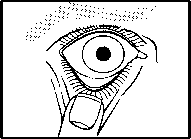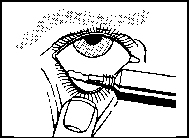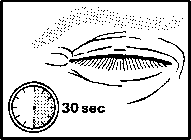Zovirax Eye Ointment
Zovirax® Eye Ointment / Aciclovir Eye Ointment
_(Aciclovir)_
3. HOW TO USE ZOVIRAX EYE OINTMENT
Always use Zovirax Eye Ointment exactly as your doctor has told you. You should check with your doctor or pharmacist if you are not sure.



PATIENT LEAFLET: INFORMATION FOR THE USER
Your medicine is available using either one of the above names, but will be referred to as Zovirax Eye Ointment throughout this leaflet.
Read all of this leaflet carefully before you start using this medicine because it contains important information for you.
• Keep this leaflet. You may need to read it again.
• If you have any further questions, ask your doctor or pharmacist.
• This medicine has been prescribed for you only. Do not pass it on to others. It may harm them, even if their signs of illness are the same as yours.
• If you get any side effects talk to your doctor or pharmacist. This includes any possible side effects not listed in this leaflet, see section 4.
In this leaflet:
1. What Zovirax Eye Ointment is and what it is used for
2. What you need to know before you use Zovirax Eye Ointment
3. How to use Zovirax Eye Ointment
4. Possible side effects
5. How to store Zovirax Eye Ointment
6. Contents of the pack and other information
1. WHAT ZOVIRAX EYE OINTMENT IS AND WHAT IT IS USED FOR
Zovirax Eye Ointment contains a medicine called aciclovir. This belongs to a group of medicines called antivirals. It is used to treat eye infections caused by the Herpes simplex virus. It works by killing or stopping the growth of viruses on the front of your eyeball (cornea).
2. WHAT YOU NEED TO KNOW BEFORE YOU USE ZOVIRAX EYE OINTMENT
Do not use Zovirax Eye Ointment if:
• you are allergic (hypersensitive) to aciclovir or valaciclovir or any of the other ingredients (listed in Section 6).
If you are not sure, talk to your doctor or pharmacist before using Zovirax Eye Ointment.
Warnings and precautions
Talk to your doctor or pharmacist before using Zovirax Eye Ointment if:
• you wear contact lenses. Stop wearing them while using Zovirax Eye Ointment.
If you are not sure, talk to your doctor or pharmacist before using Zovirax Eye Ointment.
Other medicines and Zovirax Eye Ointment.
Please tell your doctor or pharmacist if you are taking or have recently taken any other medicines. This includes medicines obtained without prescription, including herbal medicines.
Pregnancy and breast-feeding
Ask your doctor or pharmacist for advice before using any medicine.
Driving and Using Machines
You may experience blurred vision after using Zovirax Eye Ointment. Do not drive or use any machines unless your vision is clear.
Adults and children
• The usual dose is 1cm (about 1/2 an inch) of Zovirax Eye Ointment applied to the infected eye five times a day. You should space each application of Zovirax Eye Ointment by four hours. Suggested times are: 7am, 11am, 3pm, 7pm and 11pm.
• You should carry on using Zovirax Eye Ointment for at least 3 days after your eye has got better.
• Your vision may be blurred for 5 to 10 minutes after applying Zovirax Eye Ointment. Wait until you can see clearly again before driving or using any tools or machines.
How to apply Zovirax Eye Ointment to your eye
1. Wash your hands.
2. Use your finger to gently pull down the lower eyelid of your infected eye.
3. Tilt your head slightly backwards and look up.
4. Apply 1cm (about 1/2 an inch) of Zovirax Eye Ointment to the inside of your lower eyelid. Try to avoid the tip of the tube touching any part of your eye.
5. Close your eye for 30 seconds.
6. Wash your hands after applying Zovirax Eye Ointment.
If you use more Zovirax Eye Ointment than you should
Talk to your doctor or pharmacist if you use too much Zovirax Eye Ointment. Zovirax Eye Ointment is for use in the eye, if you swallow any talk to your doctor or pharmacist.
If you forget to use Zovirax Eye Ointment
• If you forget to use Zovirax Eye Ointment, use it as soon as you remember. However, if it is nearly time for your next application, skip the missed application.
• Do not use a double application to make up for a forgotten application.
4. POSSIBLE SIDE EFFECTS
Like all medicines, Zovirax Eye Ointment can cause side effects, although not everybody gets them. The following side effects may happen with this medicine:
Allergic reactions (affects less than 1 in 10,000 people)
If you have an allergic reaction, stop using Zovirax Eye Ointment and see a doctor straight
away. The signs may include:
• rash, itching or hives on your skin
• swelling of your face, lips, tongue or other parts of your body
• shortness of breath, wheezing or trouble breathing
• unexplained fever (high temperature) and feeling faint, especially when standing up.
Page 1 of 2
Other side effects include:
Very common (affects more than 1 in 10 people)
• irritation or feeling as if there is something in your eye.
Common (affects less than 1 in 100 people)
• mild stinging in your eye straight after using Zovirax Eye Ointment
• swollen, runny eyes (conjunctivitis).
Rare (affects less than 1 in 1,000 people)
• swollen eyelids.
If any of the side effects gets serious, or if you notice any side effects not listed in this leaflet, please tell your doctor or pharmacist.
Reporting of side effects
If you get any side effects, talk to your doctor or pharmacist. This includes any possible side effects not listed in this leaflet. You can also report side effects directly via the Yellow Card Scheme at: www.mhra.gov.uk/yellowcard. By reporting side effects you can help provide more information on the safety of this medicine.
5. HOW TO STORE ZOVIRAX EYE OINTMENT
• Keep this medicine in a safe place.
• Do not store above 25°C.
• Keep out of the sight and reach of children.
• Do not use this medicine after the end of the month shown on the pack.
• Keep the tube tightly closed when you are not using the ointment.
• Do not use the ointment if more than one month has passed since the tube was first opened.
• If your doctor decides to stop treatment, or if more than one month has passed since the tube was first opened, return any unused eye ointment to your pharmacist, who can dispose of it safely.
• If the ointment appears discoloured or shows any other signs of deterioration, take it to your pharmacist who will advise you.
• Medicines should not be disposed of via wastewater or household waste. Ask your pharmacist how to dispose of medicines no longer required. These measures will help to protect the environment.
6. CONTENTS OF THE PACK AND OTHER INFORMATION
What Zovirax Eye Ointment contains
Zovirax Eye Ointment contains aciclovir 3% w/w as the active ingredient.
Zovirax Eye Ointment also contains white soft paraffin.
What Zovirax Eye Ointment looks like and contents of the pack
Zovirax Eye Ointment is a sterile, off-white ointment.
Each tube contains 4.5g of ointment.
Manufacturer
Zovirax Eye Ointment is manufactured by: The Wellcome Foundation Ltd., Dartford, UK.
Or
Draxis Pharma Inc - 16751 Route Transcanadienne - KirkLand, Quebec, Canada.
Or
Glaxo Wellcome Operations UK Ltd., Harmire Road, Barnard Castle, UK.
Procured from within the EU and repackaged by:
Doncaster Pharmaceuticals Group Ltd., Kirk Sandall, Doncaster, DN3 1QR.
Page ;
Product Licence holder: Doncaster Pharmaceuticals Group Ltd., Kirk Sandall, Doncaster, DN3 1QR.
POM
PL No: 04423/0494
The information in this leaflet applies only to Zovirax Eye Ointment.
Zovirax® is a registered trademark of the GlaxoSmithKline group of companies.
Leaflet revision and issue date (Ref): 27.03.14
Other formats
To request a copy of this leaflet in Braille, large print or audio please call 01302 365000 and ask for the Regulatory Department.
Please be ready to give the following information:
Product name Zovirax Eye Ointment / Aciclovir Eye Ointment
Reference number 04423/0494
of 2